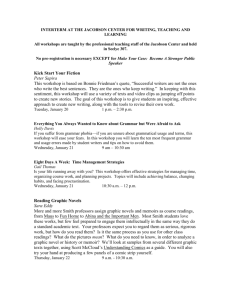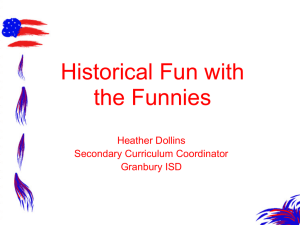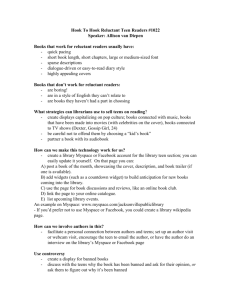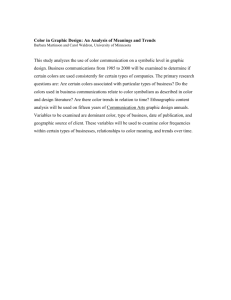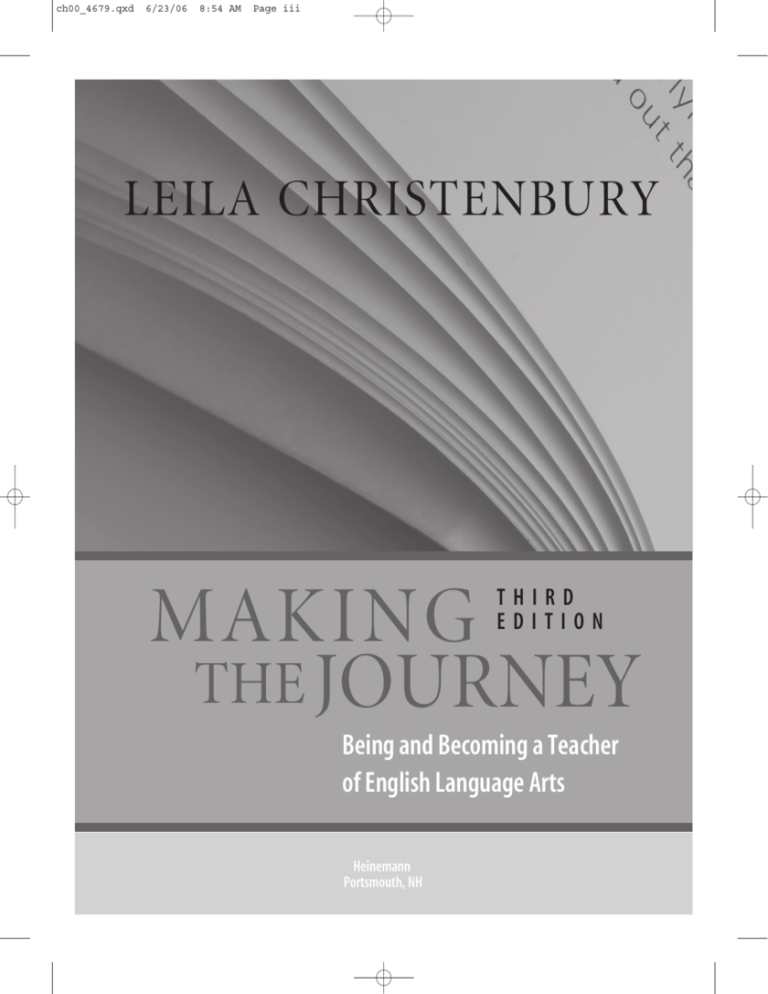
ch00_4679.qxd
6/23/06
8:54 AM
Page iii
LEILA CHRISTENBURY
MAKING
THE JOURNEY
THIRD
EDITION
Being and Becoming a Teacher
of English Language Arts
Heinemann
Portsmouth, NH
ch00_4679.qxd
6/23/06
8:54 AM
Page iv
Heinemann
A division of Reed Elsevier Inc.
361 Hanover Street
Portsmouth, NH 03801–3912
www.heinemann.com
Offices and agents throughout the world
© 2006, 2000, 1994 by Leila Christenbury
All rights reserved. No part of this book may be reproduced in any form or by any electronic or
mechanical means, including information storage and retrieval systems, without permission in
writing from the publisher, except by a reviewer, who may quote brief passages in a review.
The author and publisher wish to thank those who have generously given permission to reprint
borrowed material:
Excerpt from “East Coker” in Four Quartets by T. S. Eliot. Copyright © 1940 by T. S. Eliot and
renewed © 1968 by Esme Valerie Eliot. Reprinted by permission of Harcourt, Inc.
“Shapes, Vanishings” from The Flying Change by Henry Taylor. Copyright © 1985. Reprinted by
permission of Louisiana State University Press.
Excerpt from The House on Mango Street by Sandra Cisneros. Copyright © 1984 by Sandra
Cisneros. Published by Vintage Books, a division of Random House, Inc., and in hardcover by
Alfred A. Knopf in 1994. Reprinted by permission of Susan Bergholz Literary Services, New York.
All rights reserved.
“Central School” by Jay S. Paul. From Artemis XVI. Copyright © 1993. Published by Artemis
Artist/Writers, Roanoke, VA. Reprinted by permission of the author.
Acknowledgments for borrowed material continue on p. xii.
Library of Congress Cataloging-in-Publication Data
Christenbury, Leila.
Making the journey : being and becoming a teacher of English language arts /
Leila Christenbury.—3rd ed.
p. cm.
Includes bibliographical references and index.
ISBN 0-325-00817-5 (alk. paper)
1. Language arts (Secondary)—United States. 2. Teaching. 3. English philology—Study and
teaching—United States—Vocational guidance. 4. English language—Study and teaching—
United States. 5. Classroom management—United States. 6. English teachers—Training of.
I. Title.
LB1631.C4486 2006
428.0071'2—dc22
Editor: James Strickland
Production: Vicki Kasabian
Illustrations: Ann Glover
Cover design: Catherine Hawkes, Cat & Mouse Design
Typesetter: Publishers’ Design and Production Services, Inc.
Manufacturing: Steve Bernier
Printed in the United States of America on acid-free paper
10 09 08 07 06
RRD
1 2 3 4 5
2006010222
ch00_4679.qxd
6/23/06
8:54 AM
Page vii
CONTENTS
Acknowledgments
Using This Book
1
xi
xiii
THE TEACHER, THE STUDENT, THE SCHOOL 1
Beginnings 1
Teacher, Student, School: The Dance of the Three
The Teacher/Learner 8
The Student/Learner 14
The School 20
References 34
2
6
WHAT IT TAKES TO BE A TEACHER 36
From Expert Learner to Novice Teacher 36
What a Teacher Needs to Do 39
Beginning Your Life in the Classroom 43
The Politics of School 43
Discipline 44
Classroom Environment, Room Arrangement, Creature Comforts, Food
A Few Other Things: Getting Started, Openings, Voice, Body,
Touch, Dress 53
Teaching as Failing 58
References 64
3
PLANNING FOR YOUR TEACHING
65
Five Models of Teaching 65
Teaching Their Eyes Were Watching God and the Five Models 71
It Didn’t Work 73
Creating Activities 79
“Central School”: From Poem to Plan to Class 81
The House on Mango Street: From Chapter to Plan to Class 85
A Brief Word on Creating Tests and Test Items 88
The Place of Standards in Your Planning 89
A Final Caution About Planning 92
References 93
4
THOSE WHOM WE TEACH
94
No One Ever Said It Was Going to Be Easy 96
The Tough Times of Teaching: Apathy and Violence 97
Two Researchers on Students: William Glasser and Linda McNeil
98
47
ch00_4679.qxd
6/23/06
8:54 AM
Page viii
viii
CONTENTS
The Alienated Student: Not Always Who You Think 100
Three Students: Marianna, Antoine, and Marc 105
One Teacher’s Strategy for Dealing with Alienated Students:
“Big Bucks” 111
The Average Student: Lost in the Middle 114
The Gifted Student: Burdens and Responsibilities 114
The Delicate Contract with Students 115
Two Students: Tanya and Barry 117
References 121
5
THE WORLD OF LITERATURE: TEACHING AND SELECTING
122
The Fear of Not Knowing Enough 122
Literature: The Heart of Language Arts 124
Schools of Literary Criticism: Why You Should Care 125
The Four Schools: What to Do? 126
Transactional Theory/Reader Response 127
Organizing Literature 136
Looking at Fiction: Novels and Short Stories 139
The Lure of Nonfiction: Literary and Informational 141
Teaching and Selecting Poetry 143
The Power of Drama 145
Using Shakespeare 146
Building Bridges to Adult Reading: The Place of Young Adult Literature
New Kid on the Block: The Graphic Novel 152
The Specter of Censorship 154
Using Literature: Some Teaching Tips 156
A Final Note on Choosing Literature 166
A Story: Thurman and Architectural Digest 167
References 169
Resources 173
6
WORDS, WORDS, WORDS
178
It Ain’t Necessarily So: The English Language Arts Teacher as
Language Expert 178
Prescriptive Versus Descriptive: The World of Linguistics 179
Spelling and Vocabulary 183
The Five Grammars 185
So What Do We Do About Teaching Grammar? 186
English Language Learners 189
Language Play/Language Games 192
Sentence Combining 196
Students’ Right to Their Own Language 200
The Language of Hate 202
The Glory of Language 203
References 206
150
ch00_4679.qxd
6/23/06
8:54 AM
Page ix
ix
CONTENTS
7
WRITING AND REWRITING 209
Fifth Period, Wednesday Afternoon 209
A Traditional Model of Teaching Writing 210
A New Model of Teaching Writing 213
When Students Have a Choice: Getting Writing Ideas 216
When Students Have No Choice: Writing on Demand 219
Writing Groups: Questions, Answers, and Reasons 221
Conferencing with Students 225
The Place of Correctness and Grammar in Its Place 226
Now They’ve Written It—What Do You Do with It? 228
Creating and Using Rubrics 229
Using a Writing Portfolio 231
The Wonderful and Varied Journal 232
The Research Paper 233
What We Are About as Teachers of Writing 235
References 237
8
THE CRAFT OF QUESTIONING 239
The Power of Talk 239
Questions That Teachers Ask 241
The Questioning Circle 245
Beyond Hierarchies: Questions You Don’t Want to Ask
Questioning Behaviors 250
When Questions Don’t Work 253
Questions That Students Ask 255
References 256
9
MEDIA LITERACY 257
Issues in Media Literacy 258
Computers 262
The Internet 265
Television 268
Film 269
The Popular Culture and Media Literacy
References 272
Resources 272
10
271
A QUESTION OF ETHICS 274
English Class as Ethics Arena? 275
Ethical Issues for the Classroom Teacher 275
Breaking the Rules 281
Being and Becoming an Ethical Teacher 285
References 286
247
ch00_4679.qxd
6/23/06
8:54 AM
Page x
x
CONTENTS
11
TEACHING TODAY
288
Things Have Changed/Things Have Stayed the Same
Four Contemporary Challenges 289
Staying in the Classroom 295
The End of the Lifetime Teacher? 298
Making the Journey 299
References 301
Index
303
288
ch00_4679.qxd
6/23/06
8:54 AM
Page xi
ACKNOWLEDGMENTS
In this book I tell stories from my own years of high school and middle school teaching. In
some cases it has been appropriate not to use my students’ actual names; therefore, when
a student’s first name only is cited, it is a pseudonym. Many of the stories, however, do not
call for anonymity, and when first and last names are mentioned they are real names of students who, at one time, were in my classroom. For whatever errors of memory or detail in
these stories, I take full responsibility.
Throughout this book I also quote from the papers, journals, and notes of my students
at Virginia Commonwealth University, all of whom I have taught in English Education and
most of whom are now teaching in their first years in an English language arts classroom.
For their permission to use their words and insights, I am very grateful: I think their voices
are the strength of this book. I thank Jan Butterworth, Melissa Campbell, Carol Smith
Catron, Melissa Chai, Connie Chantelau, Lauren Dean, Werner Doerwaldt, Jane Dowrick,
Patty Duffy, Brian Durrett, Kara Elder, Paul Fanney, Susanna Field, Ronnie Fleming, Jenni
Gallo, Beverly Garner, Brenda Gates, Sheryl Gibson, Larry Goldman, Sandra Greer, Beth
Hagy, Ralph B. Holmes Jr., Jane Hunter, Donna Johnson, Jeffrey Landon, Julie Lepard, Debbie Martin, Laurie Messer, Elizabeth Milne, Johnathan Morris, Julie Morrison, Holly O’Donnell, M. Kevin O’farrell, Barbara Pope, Valerie Schwartz, Lori Shacreaw, David Small, Patti
Smith, Katherine Sullivan, Heather Talley, Anne Trippeer, Jake Tucker, Clary Washington,
and Jill Williamson.
In Chapter 4, I cite the work of my friend and teaching colleague Nancy Rosenbaum
of Patrick Henry High School, Roanoke (Virginia) City Schools; I am grateful, as I have been
for many years, for her practical and useful ideas.
Chapter 5 details a research study; to the gifted teachers who allowed my tape recorder
into their classrooms—Ellen Seay Young, then of Midlothian High School, Chesterfield
County (Virginia) Schools, and Mil Norman-Risch, of The Collegiate Schools, Richmond,
Virginia—I say thank you; and I thank their students as well.
The artist whose illustrations are in these pages is my longtime friend Ann Glover. Her
work hangs in almost every room of my house, and I am grateful for her talent and craft.
The making of a book, even a third edition, is a complicated process. I thank Jim
Strickland of Heinemann, whose enthusiasm is unflagging, and I thank production editor
Vicki Kasabian.
Friends mean the world in this writing business. I thank Tucker for his constancy and
faith, for believing I could do this, and for being there, as always, on the journey.
All through this book are stories about my students and what they taught and continue to teach me. They are the heart and soul of this book, and it would be hard to overstate my indebtedness to the thousands of people with whom I have shared the classroom
through the years. Again, I thank my students, each and every one of them, and gratefully
acknowledge their powerful and ongoing influence on my life.
xi
ch00_4679.qxd
6/23/06
8:54 AM
Page xii
Continued from p. iv:
“Breakings” from The Horseshow at Midnight and an Afternoon of Pocket Billiards by Henry Taylor.
Copyright © 1992. Reprinted by permission of Louisiana State University Press.
“Black Walnuts” by Neal Bowers. From The North American Review (June 1988, Vol. 273, No. 2).
Copyright © 1988. Reprinted by permission of the author.
“Those Winter Sundays” from Collected Poems of Robert Hayden by Robert Hayden, edited by Frederick Glaysher. Copyright © 1966 by Robert Hayden. Used by permission of Liveright Publishing
Corporation.
“Cold Snap” by James Hearst from The Complete Poetry of James Hearst, edited by Scott Cawelti.
Copyright © 2001. Reprinted by permission of the editor.
Excerpt from Horace’s Compromise: The Dilemma of the American High School by Theodore R. Sizer.
Copyright © 1984 by Theodore R. Sizer. Reprinted by permission of Houghton Mifflin Company.
All rights reserved.
xii
ch00_4679.qxd
6/23/06
8:54 AM
Page xiii
USING THIS BOOK
In many ways, Making the Journey is a very personal book, and your reactions and comments
are important as you read. The journal suggestions throughout the chapters may help you
codify your own response to the activities and ideas presented here; I urge you to buy a
journal and to use it with this book. The habit of journal writing is a valuable one, and what
you write may surprise you. In addition, a journal is a good place for you to consider issues
about you, your ideas, and why and how you are making this journey of being and becoming a teacher.
The Third Edition
Much has happened to me as a teacher since the second edition of Making the Journey, and
I have tried to reflect my thinking and my reading in this third edition. In the past few years,
I completed a term as president of the National Council of Teachers of English, I returned
to a high school where for a semester I taught English 11, and, through a grant project, for
the first time I became seriously involved with issues of teaching English language learners.
Just recently, concerns about timed writing tests led me, with two colleagues, to write books
for teachers and students regarding writing on demand. All of these experiences have given
me new insights that I share in this third edition of Making the Journey.
I am especially grateful, as always, to my students at Virginia Commonwealth University, and I thank them for their advice regarding what this edition needed to offer. In
particular, I am grateful to my students and now new teachers: Misty Burton, Beverly Garner,
Shannon Garofalo, Bethany Harrar, Heidi Hoffer Garcia, Julie Isman, Zonita James, Allison
Kelley, Katherine Leake, Kim McDonnell, Lorraine Rand, Jacob Rheaume, Afaf Salem, and
Mark Spewak, all of whom helped me determine what needed to stay in this third edition,
what needed to be added, and what needed to change.
I also continue to hear from readers of Journey with whom I have corresponded both
by letter and e-mail. The positive reaction of these readers, teachers beginning on their journey, has continued to be a moving and wholly unexpected dividend to writing and revising this book. It has also, practically, guided me in this third edition as I have tried to attend
to readers’ questions, suggestions, and comments.
Working on this revision has, once again, given me a renewed appreciation of the
tremendous courage it takes to begin the journey of teaching. It has never been easy to make
a life in the classroom, and today it is as challenging as ever to be an effective teacher. To
those of you just entering the classroom, I send you my best as you embark upon this daunting but crucially important venture. May you find both strength and grace on the journey.
xiii
ch05_4679.qxd
6/15/06
2:24 PM
Page 152
152
MAKING THE JOURNEY
At any rate, insisting that students read classics or nothing often results in the latter:
students, confronted with literature with which they can make little personal connection,
choose, often quietly but often permanently, to stop reading altogether—or to confine
reading to only that which is required by English class.
The subject matter and language in YA novels Along with other issues such as the
place of the classics and Young Adult literature, the question of censorship is a very real one
when teachers consider using YA literature in class. All of the hot topics—sex, drugs, suicide, parental tensions, race, poverty—are touched on in much YA literature, and often the
characters speak in realistic dialogue incorporating slang and an occasional obscenity. In
fact, the realism of much of YA literature may be part of its popularity with young people.
Again, the issue is polarized: all good literature addresses the hot topics, but for many people, unfortunately some teachers and librarians included, hot topics are acceptable in
antique dress but not in today’s clothing. There is nothing Robert Cormier’s frequently censored The Chocolate War discusses that William Shakespeare or Nathaniel Hawthorne or Herman Melville avoid. Put the same themes in modern times, however, and discuss them in
contemporary language, and many people become wary and worry that young people will
be exposed to something they might otherwise never learn—or will learn sometime in that
distant future when they can “handle” it. Truth be told, life is not that way, and young people need truth in today’s language as much as in the language of yesteryear.
Keeping students reading is one of the gifts of YA literature; it is a powerful tool we
can use both in and outside the classroom and can provide a bridge to more sophisticated,
lengthy and complicated reading.
New Kid on the Block: The Graphic Novel
While YA literature occupies a corner in some English classrooms, graphic novels have not
been readily accepted into many school district curricula. Their time, however, may indeed
come soon; the genre is rapidly developing, and it is expanding into wider spheres. For
instance, Scholastic, a well-respected and long established publisher of young adult and
other fiction, has launched Graphix, a division devoted solely to graphic novels and has
begun the publication of a classic series, Jeff Smith’s funny and appealing Bone. The American Library Association has established a “Great Graphic Novels for Teens” list among its
more traditional booklists and book awards and regularly updates nominations to the list.
Scholarly and historical books such as Scott McCloud’s Understanding Comics and Stephen
Weiner’s Faster Than a Speeding Bullet: The Rise of the Graphic Novel provide background and
frame for this unusual genre. Time, a national news magazine, is currently including in its
weekly issues the work of Chris Ware, the creator of American Book Award-winning Jimmy
Corrigan.
Some of this may be a surprise to you, and some of it may not. Certainly you may
know graphic novels from two examples that have been more widely read in schools, Art
Spiegelman’s Pulitzer prize–winning Maus (followed by Maus II). Though the format uses
the frames and dialogue of a comic book and the characters are animals, the subject is a
deadly serious fable of Nazi Germany where the Jews are portrayed as mice and the Nazi as
cats. You may also have familiarity with Manga, Japanese graphic novels that feature superheroes. There is, however, more range to the field than the examples cited here might suggest.
While many know the field of graphic novels largely through super heroes (such as Spider
ch05_4679.qxd
6/15/06
2:24 PM
Page 153
THE WORLD OF LITERATURE
Man, X-Men, Batman, and the Hulk), graphic novels also include horror, realistic fiction,
science fiction, fantasy, nonfiction, and literary adaptations and interpretations.
Don Gallo, in a recent English Journal column, defines the genre of graphic novels as
“elaborately illustrated stories that look like high-class, book-length comics” and “something
between an emerging literary form and a cultural phenomenon” (114). Indeed, for many of
our students, graphic novels are not just fancy comic books but exciting and interesting
reading. Another brief but potent thing to remember about graphic novels is their unique
appeal; they are, in a phrase, cutting edge, and that fact alone may make them especially
enticing to certain students. Peter Schjeldahl, writing in The New Yorker, observes:
Consuming them [graphic novels]—toggling for hours between the incommensurable functions of reading and looking—is taxing. The difficulty of graphic novels limits their potential
audience, in contrast to the blissfully easeful, still all-conquering movies, but that is not a debility; rather, it gives them the opalescent sheen of avant-gardism. (162)
From a teacher’s perspective, graphic novels provide an innovative combination of art
and prose, and the many unusual topics of graphic novels make them interesting choices
for supplementary reading in the classroom and as lures for students who would otherwise
be reluctant to pick up and finish a traditional book. In addition, graphic novels’ extensive
use of dialogue and unusual narrative form can be studied and replicated in the classroom.
Interested students can both transform parts of traditional prose works into short graphic
novels and can also assess the art and its effect in graphic novels.
What else can a teacher do with a graphic novel? Depending on the novel’s subject
matter, there are actually a number of things.
Comparing the graphic novel superhero to a classic epic hero While the stories of Batman or the X-Men may seem like something from childhood, their exploits are detailed
seriously in graphic novels. Ask students to compare and contrast Ulysses, Beowulf, or King
Arthur to a superhero. To what extent are the trials and challenges the same? different? How
do the visuals of the graphic novel give a reader more—or different—detail than the poetry
of Homer or Tennyson?
Using graphic novels that are based on classics For students eager to go to Spark Notes
rather than read the original, a graphic novel may be a good companion choice. Puffin Graphics has a series that has adapted Frankenstein, as well as other classics, to the graphic format.
Ask students to read a graphic novel adaptation in companion with some of the original work.
What is changed? preserved? How does the graphic presentation enhance or alter the original prose?
Contrasting the graphic novel to the film The Adventures of the League of Extraordinary
Gentleman are recounted in a series of graphic novels as well as in film. Ask students to view
both and compare and contrast in particular the visuals. To what extent does the film mimic
or alter the graphic novel? Which is more effective and why?
Enticing reluctant readers There are graphic novels that also feature specifically young
adult themes. One recent example is Queen Bee, the story of Haley, a middle schooler and former geek who has special powers and will be using them to attempt to win a local American
Idol-type contest. Another is the series Runaways, the tale of six teens who find that their parents are secretly super-powerful villains who they must resist. Given the subject matter and
the format, both of these graphic novels may be very appealing to reluctant readers.
153
ch05_4679.qxd
6/15/06
2:24 PM
Page 154
154
MAKING THE JOURNEY
Using graphic novels as approaches to difficult subjects Like Maus, some graphic
novels are very serious, and Joe Sacco’s Safe Area Gorazde is the story of the war in Eastern
Bosnia from 1992 to 1995. Well researched and factual, Safe Area Gorazde is journalism
presented in the form of a graphic novel and is a mature and complicated read.
For more suggestions regarding graphic novels, see the Resources section at the end
of this chapter.
.................. FOR YOUR JOURNAL ..................
YA and many (but not all) graphic novels are not lengthy, and you
will probably be able to read one in a brief period of time. Go to
your local library or bookstore and browse in the young adult section; consult the Resources section at the at the end of this chapter.
Read a YA work or graphic novel and write about it briefly: how
did you react to it? Who do you think would like to read such a
book? How do you assess it in terms of tightness of plot, believability of characters, realism in dialogue, appropriateness of setting,
importance of theme, accuracy of information? Regarding the
graphic novel, what do you notice as far as art, color, placement?
To what extent does the presentation enhance the subject matter?
Can you think of any adult or “classic” work you could pair this
book with? What similarities/differences do you see?
The Specter of Censorship
Whenever a teacher uses a poem, a novel, a play, or a piece of nonfiction in a classroom, he
or she is open to the question of censorship. There is—the evidence is virtually irrefutable—
no piece of literature “safe” from challenge and censorship. From all kinds of popular magazines to the most revered of the classics, reading material is regularly questioned and
occasionally removed from library and classroom shelves. Sometimes the courts, as high as
the Supreme Court, are involved in censorship cases. Most times the challenges are handled
at the individual classroom, the school, or the school board level.
While there are few of us who would relish such a battle or the attack on our professionalism, we as teachers need to be prepared to give a rational defense of why we are
asking—or, as some people might think, allowing—our students to read certain materials
in our classes. The American Library Association (ALA) and the National Council of Teachers of English (NCTE) have many resources available to teachers and schools regarding books
that are challenged. A few that may be helpful are the NCTE’s publication The Students’
Right to Read and Burress and Jenkinson’s The Students’ Right to Know (both have overviews
of censorship and a helpful form for those who would like a book reconsidered). Similarly
invaluable is the ALA’s Hit List: Frequently Challenged Books for Young Adults, which gives
teachers sources outside their own judgment as to what is a good book. In the meantime,
however, the following five principles may help you.
ch05_4679.qxd
6/15/06
2:24 PM
Page 155
THE WORLD OF LITERATURE
1. Find out if your school has a materials selection policy and a procedure for
dealing with books that are challenged. If it does, get a copy. If it doesn’t,
raise the issue: without something in writing, schools are unprepared to deal
quickly and effectively with a parental or public complaint.
2. Find out if your department has a file of rationales for books that are taught
in classes. Making up rationales and keeping them on file is powerful ammunition when books are questioned by parents and members of the public.
Printed rationales or techniques for writing your own are available from ALA;
NCTE has books on the topic and has also, in cooperation with the International Reading Association (IRA), compiled a CD-ROM, Rationales for Challenged
Books Grades 4–12.
3. Get a copy of NCTE’s publication “Citizen’s Request for the Reconsideration
of a Work of Literature” (from the NCTE publication cited, The Students’
Right to Read). It is a workable and usable form to give parents and others who
question a work you might be teaching.
4. As you teach and select, do keep in mind what merit you feel the material
has for your students. If you really don’t know why you are using something,
even if it is in the mandated textbook, maybe you don’t need to teach it. Conviction is important in this business, and there are so many great things from
which to choose and which are highly defensible.
5. Finally, if a work you have selected or allowed is questioned, it is in your
best interest to always assume that the challenger is a person of good will.
Civility, respect, and helpfulness are characteristics you should strive for, even
in such an emotionally charged situation. Remember, parents and members of
the public do have the right to ask questions and receive answers. Sometimes the
underlying reason for their inquiry is simply that they are uninformed or unsure
about the merit of literature with which they are unfamiliar.
If your school has a materials selection policy and a procedure for dealing with complaints,
and you have a rationale on hand, the issue can usually be resolved amicably. On the other
hand, if you find yourself without those resources, there are others who can help you—your
local education association, your local language arts association, or, as mentioned, ALA and
NCTE. The attempt to censor and restrict is almost as old as writing itself; while you may
have never thought of it in this way, it is an ongoing effort to keep library shelves freely
stocked and students reading widely. In no case, however, should you stand alone. Censorship challenges can be emotional and scary (the Nat Hentoff YA novel The Day They Came
to Arrest the Book tells one such story), and teachers need to avail themselves of outside
resources.
When we discuss this issue, it is also almost impossible not to cite John Milton’s stirring and still very apt Areopagitica, his defense of writing against the censor. Milton wrote
this pamphlet in 1644 in response to the censorship prevalent in seventeenth-century England. Addressed to the British parliament for the “liberty of unlicensed printing,” Milton
thundered about protecting the reading public through “a fugitive and cloister’d vertue, unexercis’d and unbreath’d” (691). He argued that even in a restrictive, theocratic society, reading would not sully anyone; he concluded it was better to kill a person than a book—because
a book was so akin to a likeness of the divine:
155
ch05_4679.qxd
6/15/06
2:24 PM
Page 156
156
MAKING THE JOURNEY
as good almost kill a Man as kill a good
Booke; who kills a Man kills a reasonable
creature, God’s Image: but hee who destroyes a
good Booke, kills reason it selfe, kills the
Image of God, as it were in the eye. (681)
On a less elevated—but no less compelling—plane is E. B. White, who wrote in 1949 in
The New Yorker regarding the New York Board of Education’s criteria for selecting books.
The criteria are strongly reminiscent of today’s concerns:
The Board of Education has twenty-three criteria for selecting textbooks, library books, and
magazines for use in the public schools. We learned this by reading a fourteen-page pamphlet
published by the Board explaining how it makes its choice. One criterion is: “Is it [the book or
magazine] free from subject matter that tends to irreverence for things held sacred?” Another
criterion is: “Are both sides of controversial issues presented with fairness?” Another: “Is it free
from objectionable slang expressions which will interfere with the building of good language
habits?” (140)
White worries in his essay that “these three criteria by themselves are enough to keep a lot
of good books from the schools.” He goes on to note:
Irreverence for things held sacred has started many a writer on his way, and will again. An
author so little moved by a controversy that he can present both sides fairly is not likely to burn
any holes in the paper. We think the way for school children to get both sides of a controversy
is to read several books on the subject, not one. In other words we think the Board should strive
for a well-balanced library, not a well-balanced book. The greatest books are heavily slanted,
by the nature of greatness. (140)
I wish I had written that.
Using Literature: Some Teaching Tips
There are a number of books available, especially from NCTE, that regularly provide teaching tips on specific works. Use your English Journal (the NCTE magazine for secondary teachers), state language arts publications, and Notes Plus and similar publications for teaching
ideas. Publishers also offer teaching guides, many of which are written by teachers in the
classroom and by YA authors. In general, however, there are a number of principles to keep
in mind when you think of using literature.
Limit your time
Covering every aspect of any piece of literature is deadening, and furthermore, real readers
don’t approach literature that way. Why is it in the classroom we beat poems and short stories and novels to death, exhausting every avenue of discussion and, in the process, our students, too?
Think about limiting the time you spend on what your students are reading and try to
fall in love with the concept that it is better to leave them wanting to discuss more, do more,
than to end a unit of study with everyone cranky and worn out and just sick of the piece.
It’s the extensive versus intensive debate, and I, for one, always opt for the former. I would
rather range over a wide variety of works than spend significant portions of time exhausting a single piece. From my experience, extensive, not intensive, reading seems to give students a wider range of ideas and facility.
Thank you for sampling this
resource.
For more information or to
purchase, please visit
Heinemann by clicking the link
below:
http://www.heinemann.com/products/E00817.aspx
Use of this material is solely for
individual, noncommercial use and is
for informational purposes only.


